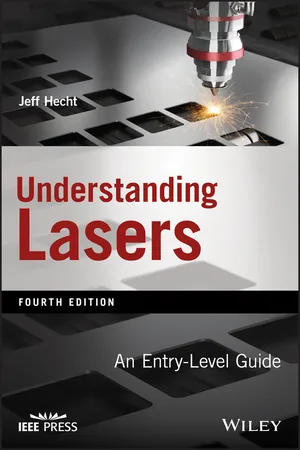
- English
- ePUB (mobile friendly)
- Available on iOS & Android
About this book
The expanded fourth edition of the book that offers an essential introduction to laser technology and the newest developments in the field
The revised and updated fourth edition of Understanding Lasers offers an essential guide and introduction that explores how lasers work, what they do, and how they are applied in the real world. The author—a Fellow of The Optical Society—reviews the key concepts of physics and optics that are essential for understanding lasers and explains how lasers operate. The book also contains information on the optical accessories used with lasers.
Written in non-technical terms, the book gives an overview of the wide-variety laser types and configurations. Understanding Lasers covers fiber, solid-state, excimer, helium-neon, carbon dioxide, free-electron lasers, and more. In addition, the book also explains concepts such as the difference between laser oscillation and amplification, the importance of laser gain, and tunable lasers. The updated fourth edition highlights the most recent research and development in the field. This important resource:
- Includes a new chapter on fiber lasers and amplifiers
- Reviews new topics on physics of optical fibers and fiber lasers, disk lasers, and Ytterbium lasers
- Contains new sections on Laser Geometry and Implications, Diode Laser Structures, Optimal Parametric Sources, and 3D Printing and Additive Manufacturing
- Puts the focus on research and emerging developments in areas such as spectroscopy, slow light, laser cooling, and extremely precise measurements
- Contains appendices, glossary, and index that help make this book a useful reference
Written for engineering and physics students, engineers, scientists, and technicians, the fourth edition of Understanding Lasers contains the basic concepts of lasers and the most recent advances in the technology.
Frequently asked questions
- Essential is ideal for learners and professionals who enjoy exploring a wide range of subjects. Access the Essential Library with 800,000+ trusted titles and best-sellers across business, personal growth, and the humanities. Includes unlimited reading time and Standard Read Aloud voice.
- Complete: Perfect for advanced learners and researchers needing full, unrestricted access. Unlock 1.4M+ books across hundreds of subjects, including academic and specialized titles. The Complete Plan also includes advanced features like Premium Read Aloud and Research Assistant.
Please note we cannot support devices running on iOS 13 and Android 7 or earlier. Learn more about using the app.
Information
CHAPTER 1
Introduction and Overview
About This Chapter
1.1 LASERS, OPTICS, AND PHOTONICS
1.2 UNDERSTANDING THE LASER
Table of contents
- COVER
- TITLEPAGE
- Copyright
- Dedication
- PREFACE
- CHAPTER 1 INTRODUCTION AND OVERVIEW
- CHAPTER 2 PHYSICAL BASICS
- CHAPTER 3 HOW LASERS WORK
- CHAPTER 4 LASER CHARACTERISTICS
- CHAPTER 5 OPTICS, LASER ACCESSORIES, AND MEASUREMENTS
- CHAPTER 6 LASER TYPES, FEATURES, AND ENHANCEMENTS
- CHAPTER 7 GAS LASERS
- CHAPTER 8 SOLID-STATE LASERS
- CHAPTER 9 FIBER LASERS AND AMPLIFIERS
- CHAPTER 10 DIODE AND OTHER SEMICONDUCTOR LASERS
- CHAPTER 11 OTHER LASERS AND LASER-LIKE SOURCES
- CHAPTER 12 LOW-POWER LASER APPLICATIONS
- CHAPTER 13 HIGH-POWER LASER APPLICATIONS
- CHAPTER 14 LASERS IN RESEARCH
- ANSWERS TO QUIZ QUESTIONS
- APPENDIX A LASER SAFETY
- APPENDIX B HANDY NUMBERS AND FORMULAS
- APPENDIX C RESOURCES AND SUGGESTED READINGS
- GLOSSARY
- INDEX
- EULA